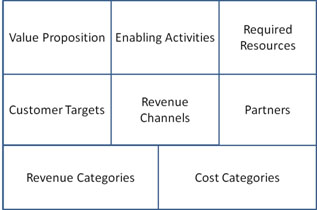A new trend in business strategy development involves viewing your business from the perspective of the “business model”. The business model provides templates for business executives to think about their costs and revenues, customers, channels and partners, and various activities and resources with a focus on maximizing profits and other measures of success. The business model is particularly powerful as a vehicle for getting all views of a business into a simple framework from which management teams can drive a common strategy that ties together disparate aspects of a business.
For example, in Alexander Osterwalder’s book, Business Model Generation, he discussed nine aspects of the business modeli. These included customer segments, value propositions, channels, customer relationships, revenue streams, resources, activities, partnerships and cost structures. Figure one depicts one of many potential variations or interpretations of the Osterwalder business model.

Figure One: A Sample Business Model Template
Using templates, like the one in figure one, executives can identify critical goals for each business category, assign executive sponsorship to ensure that these goals are met and tie the concepts together in a broader strategy. While business models provide focal points for executives to focus planning, investment and revenue related strategies, translating these business models into actionable results is another matter. The real challenge comes when executive teams must craft a phased, clearly articulated strategy that identifies key initiatives, deployment plan and funding model that can deliver success as defined in the business model. This is where business architecture comes into play.
Turning Business Models into Actionable Results
Business architecture represents basic business DNA through the capability map, comprehensive views on how to deliver end-to-end stakeholder value through value streams, business information and organization mapsii. But how do business models align to business architecture? At first glance business architecture and the business model may seem redundant or just different views of the same concepts, but this is not the case. While business models focus on success, typically in monetary terms, business architecture represents the fundamental building blocks of a business. These building blocks can be rearranged, assembled, added and improved in countless ways to enable a successful business model.
Consider that capabilities and information maps provide an absolute view of what a business has the capability to do and the information that enables those capabilities. Capabilities may be strong or weak, deployed consistently or inconsistently, or even hidden from view. Capabilities and information concepts simply define the essence of a business in absolute terms, while the business model presents views that enable everyone to see how an organization plans to be successful. The business model might suggest that certain capabilities need to be improved, across certain business units. Business architecture can be used to craft a clear approach, deployment plan and cost model for meeting this goal.
For example, a group of executives defined a business model that was to be used to inform decisions across the enterprise. Every decision was to be examined from four perspectives: customer, operations, profit, and partner. This four-sided view of the business opened up opportunities to leverage business architecture in achieving success.
The business architecture team quickly responded. First, they examined how different business architecture views could be applied to each of the four business model criteria. One example involved mapping externally facing aspects of certain value streams to the customer and partner concepts in the business model while mapping internally facing aspects of these same value streams to operational and financial concepts in the business model. A decision to introduce a new customer service could then view all value streams related to the creation and delivery of that service.
A second step taken by the business architecture team involved using the four criteria in the business model to evaluate how well certain capabilities were performing. The resulting capability “heat map” then became more naturally acceptable to executives, who in turn were willing to fund improvements to various value streams and capabilities because it aligned to their business model viewiii.
Business architecture also provides a natural path for identifying IT architecture strategy. Capability, information and value maps all have direct and distinct mappings to IT application, services and data architecture. As a result, business architecture provides IT with a means of interpreting high-level business vision and strategy in ways that can be turned into unambiguous projects, programs and solutions – tying IT strategy directly to the business model in ways that everyone can understand and executives can fund.
In summary, business models serve as a means of communicating how business architecture teams can help an organization in ways that align to an executive vision. The business model in many cases becomes a way to clarify organizational vision and strategy. The business architecture in turn provides the means to translate that vision and strategy into actionable results by highlighting impacts on organizational DNA that need to be transformed in specific ways to achieve success.
iAlexander Osterwalder and Yves Pigneur, Business Model Generation, (Self Published, 2010), 16-17.
ii Business Architecture Guild, “Business Architecture Body of Knowledge Handbook 2.0”, Section 1: Introduction, 2011, www.businessarchitectureguild.org.
iiiThe heat map is a color coded capability map based on how well certain capabilities were performing in the business.

















